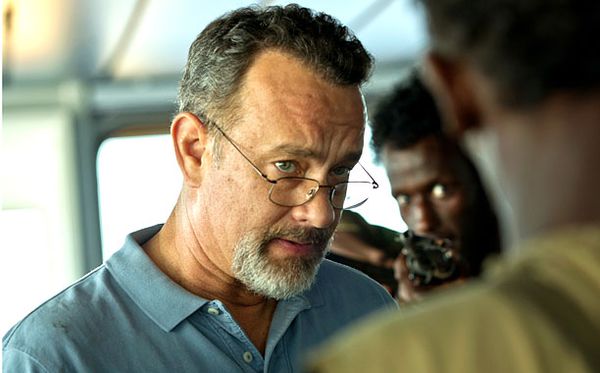Eye For Film >> Movies >> Captain Phillips (2013) Film Review
Captain Phillips
Reviewed by: Anne-Katrin Titze

Tom Hanks as Captain Phillips has a truthfulness as powerful as the undertow with storytelling by Paul Greengrass that propels you to the edge of your seat.
Captain Phillips is a man ill at ease. Vermont, March 28, the titles on the screen time stamp. He is in a rush, packing. The hand-held camera, no surprise in a Greengrass movie, follows him shaking, wavering. His wife, Andrea (Catherine Keener), confirms, “I know this is what we do.” In the car to the airport the couple talk about the children, everything feels rushed, slightly clumsy, and very tense. “It’s going to be okay?” she asks. Her husband is in the Merchant Marines.

Cut to Somalia. The yellow light is in sharp contrast to the bluish gray of Vermont. The movements are a different kind of fast. A coastal Somali village is approached by a group of men in vehicles. They have guns, shout, push the cocked weapons into the faces of the villagers, the metal clicks and threatens. You can hardly take a breath. A boat is pulled into the water. The young men, frightfully thin, resemble the images of concentration camp survivors.
Skin and bones dressed in rags, their movements driven by feverish nervous energy. They are pirates and they call themselves fishermen and their waters have been illegally, industrially emptied. Due to the depletion of resources off the coast of Somalia, the option presented to these young men to survive is the hijacking of cargo ships passing the Horn of Africa, organised by crime cartels.
Based on the 2009 hijacking of the US cargo ship Maersk Alabama, the screenplay by Billy Ray was constructed from the book, A Captain's Duty: Somali Pirates, Navy SEALs, and Dangerous Days at Sea, by Richard Phillips with Stephan Talty.
The film refuses the traps of the biopic. We are on the boat(s) with the captain, the crew, the pirates and the US rescue operation all the way. No scenes show the worried family watching the news, nor the Somali warlords putting pressure on the pirates' village. Greengrass trusts that we understood the first time and keeps us fully engaged.
The soundtrack is nervous. Once Phillips arrives on-board he is still tense but calmer. At the New York Film Festival press conference before the world premiere, Tom Hanks called the discrepancy in behaviour between Phillips on land and on the job at sea the key he was given to the character after visiting the Phillips family. The real wife told Hanks about her husband's serious calm confronting the dangers of the sea. It is a duplicate key that matches Catherine Breillat's observation on vertigo in the context of Abuse Of Weakness. The anticipation is so unbearable that the actual fall comes as a relief.
Tom Hanks gives a performance that reflects the cliff and the apprehension pounces over to the audience. We know the pirates will come on board, just as we know about the Titanic. The crew's breakfast looks real, not scenic, because it wasn't reconstructed in a Hollywood studio or CGI. The filming took place on the Maersk Alabama's sister-ship, the Maersk Alexander.
The discrepancy in size between the attackers and the attacked is enormous. The premise questions our storytelling conventions. The underdog doesn't win here. The big system rescues their own. This is the emotional demand of a thorough thriller. How can a little boat at full speed, holding four desperate skinny men in rags with their guns, pose any real danger? "The coward is the first one in the grave" is the pirates' morale-boosting axiom.
Captain Philllips looks up "piracy" online. His face, with inoffensive metal glasses and suburban beard, is collocated with that of Barkhad Abdi, playing Muse, the leader of the quartet, who is tense, hardened, desperate. When the two captains look at each other through binoculars something happens.
Barkhad Abdirahman plays Bilal, Faysal Ahmed plays Najee, and Mahat M. Ali plays Elmi. The four young men are new to acting, were cast together in Minnesota and give fierce, fearless performances.
Phillips and his crew, some of them actual seafarers, are draped in blue; the pirates' rags tint them in reds and yellows, an interesting color coding progressing into the lifeboat and beyond. "Relax, it's just business," Muse tries to convince everyone, especially himself. Hanks goes through remarkable transformations when as hostage, his face becomes a canvas on which fears of the unknown are drawn.
Greengrass mirrors without flash. The pirate fishing skiff's motor breaks down. Later Phillips uses the "broken" ship as a tactic of distraction. There is no air in the engine room. Later the air in the enclosed lifeboat turns bad. Facts? Yes, probably. When the drugs and tobacco the Somalis are on start to wear off, the unpredictability goes through the roof.
"What's left for us to fish?" is the most urgent question, though, that remains, long after "the SEALs take care of" the matter-at-hand.
Reviewed on: 02 Oct 2013

















